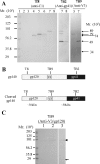Generation of mucosal anti-human immunodeficiency virus type 1 T-cell responses by recombinant Mycobacterium smegmatis
- PMID: 16943347
- PMCID: PMC1656549
- DOI: 10.1128/CVI.00195-06
Generation of mucosal anti-human immunodeficiency virus type 1 T-cell responses by recombinant Mycobacterium smegmatis
Abstract
A successful vaccine vector for human immunodeficiency virus type 1 (HIV-1) should induce anti-HIV-1 immune responses at mucosal sites. We have generated recombinant Mycobacterium smegmatis vectors that express the HIV-1 group M consensus envelope protein (Env) as a surface, intracellular, or secreted protein and have tested them in animals for induction of both anti-HIV-1 T-cell and antibody responses. Recombinant M. smegmatis engineered for expression of secreted protein induced optimal T-cell gamma interferon enzyme-linked immunospot assay responses to HIV-1 envelope in the spleen, female reproductive tract, and lungs. Unlike with the induction of T-cell responses, priming and boosting with recombinant M. smegmatis did not induce anti-HIV-1 envelope antibody responses, due primarily to insufficient protein expression of the insert. However, immunization with recombinant M. smegmatis expressing HIV-1 Env was able to prime for an HIV-1 Env protein boost for the induction of anti-HIV-1 antibody responses.
Figures





References
-
- Aldovini, A., and R. A. Young. 1991. Humoral and cell-mediated immune responses to live recombinant BCG-HIV vaccines. Nature 351:479-482. - PubMed
-
- Cayabyab, M. J., A. H. Hovav, T. Hsu, G. R. Krivulka, M. A. Lifton, D. A. Gorgone, G. J. Fennelly, B. F. Haynes, W. R. Jacobs, Jr., and N. L. Letvin. 2006. Generation of CD8+ T-cell responses by a recombinant nonpathogenic Mycobacterium smegmatis vaccine vector expressing human immunodeficiency virus type 1 Env. J. Virol. 80:1645-1652. - PMC - PubMed
-
- DasGupta, S. K., S. Jain, D. Kaushal, and A. K. Tyagi. 1998. Expression systems for study of mycobacterial gene regulation and development of recombinant BCG vaccines. Biochem. Biophys. Res. Commun. 246:797-804. - PubMed
-
- Elloumi-Zghal, H., M. R. Barbouche, J. Chemli, M. Bejaoui, A. Harbi, N. Snoussi, S. Abdelhak, and K. Dellagi. 2002. Clinical and genetic heterogeneity of inherited autosomal recessive susceptibility to disseminated Mycobacterium bovis bacille Calmette-Guerin infection. J. Infect. Dis. 185:1468-1475. - PubMed
-
- Gao, F., B. T. Korber, E. Weaver, H. X. Liao, B. H. Hahn, and B. F. Haynes. 2004. Centralized immunogens as a vaccine strategy to overcome HIV-1 diversity. Expert Rev. Vaccines 3:S161-S168. - PubMed
Publication types
MeSH terms
Substances
Grants and funding
LinkOut - more resources
Full Text Sources
Other Literature Sources

